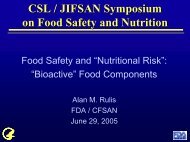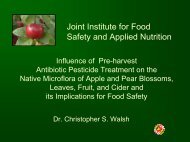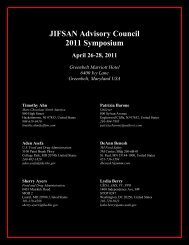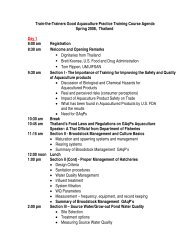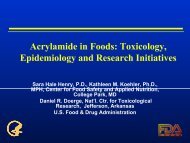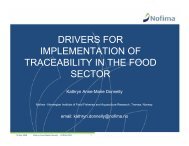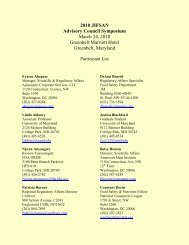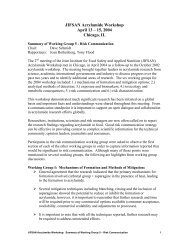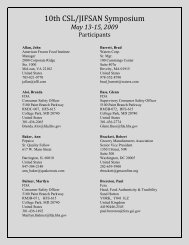Risk Criteria - jifsan
Risk Criteria - jifsan
Risk Criteria - jifsan
- No tags were found...
You also want an ePaper? Increase the reach of your titles
YUMPU automatically turns print PDFs into web optimized ePapers that Google loves.
<strong>Risk</strong> Ranking FrameworkThe IFT-FDA FDA Cooperative InitiativePresentation at JFSAN Workshop: Tools forPrioritizing Food Safety ConcernsByNga TranJune 4, 2007
Overview: The Charge• Develop a risk-ranking ranking framework• Facilitate the evaluation and ranking ofmicrobiological agents, toxins, andchemicals– Quantitatively or semi-quantitativelycomparing and determining potential healththreats– Evaluating interventions or control points …to protect the food supply.
Overview: ParticipantsFrank F. Busta, , PhD (U. Minnesota)Sherri Dennis, PhD (FDA)Joseph Hotchkiss, PhD (Cornell Univ.)Lee-AnnJaykus, , PhD (NC State)Jennifer McEntire, , PhD (IFT)Marianne Miliotis, , PhD (FDA)Rosie Newsome, PhD (IFT)Greg Paoli, MAS (Decisionanalysis(Decisionanalysis)Barbara Petersen, PhD, MPH (Exponent)Donald Schaffner, , PhD (Rutgers Univ.)Fred Shank, PhD (IFT)Bruce Tompkin, , PhD (ConAgra)Nga Tran, DrPH, , MPH (Exponent)Mary Wagner, PhD (E & J Gallo Winery)
Overview: The Process• Two years (2003-2005)2005)• Reviewed literature and other developments• Developed risk ranking criteria modules andintegration algorithm• Developed, deliberated, implemented andpeer reviewed a web-based based prototype
<strong>Risk</strong> Ranking Prototype Highlights• <strong>Risk</strong> criteria– Exposure (prevalence and concentration, foodintake)– Dose response– <strong>Risk</strong> characterization and public health impacts• Module components– Expert insight, evidence databases– Hazard metrics/weights, decision logic, help files• Module integration via algorithms and evidencehierarchy
<strong>Risk</strong> <strong>Criteria</strong>: ExposurePrevalence,concentration atdeparture from thefarm gatePrevalence,concentration at theshipping dock (uponleaving themanufacturer)I) PrimaryProductionII) ProcessingIII) DistributionA. Likelihood of hazardintroduction?B. How Controllable isthe hazard?C. Potential for abuse,mishandlingPrevalence,concentration afterdistribution andstorageIV) Retail,ConsumersPrevalence,concentration at timeof consumptionFood Intake
Prevalence and Levels• Expert insights (microbe); Data/Evidence(chemical)• Prevalence: yes/no (microbe); non-detects(chemical)• Enumeration:– log units/g (microbes)– g/g scale (chemicals)
Food Intake• US survey data (e.g. Continuing Survey ofFood Intakes by Individuals (CSFII) 1996-98• Exposed population and quantity offood consumed:grams/eating occasiongrams/daygrams/kg body weight per day
<strong>Risk</strong> <strong>Criteria</strong>: Hazard Characterizationor Dose Response• Multiple Endpoints:• Chemical: cancer, non-cancer (acute andchronic)• Micro: infectious or toxigenic• Multiple dose-response models• Toxigenic responses: exponential, stepthreshold, threshold linear, non-threshold linearand cancer• Infectious responses: Beta-Poisson,exponential, threshold linear, and non-thresholdlinear.
<strong>Criteria</strong>: <strong>Risk</strong> Characterization• Monte Carlo simulation:– A range of doses combined with dose-responsemodel(s)– Mean probability of illness• Traditional chemical and micro approaches– Chemical: lifetime and annual risk, exposedpopulation, annualized cases– Micro: risk per serving, annual contaminated servings,annualized cases
<strong>Risk</strong> <strong>Criteria</strong>: Public Health Impacts• <strong>Risk</strong> estimates expressed as annual p-DALYs pforboth microbes and chemicals• Pseudo (p)-Disability Adjusted Life Years (DALY)• Alternatives to disease specific DALYDALY = disability adjusted life years = YLL + YLDYLL = years of life lostYLD = years lived with disability• Mean to rank public health impacts across chemicaland micro food risks
p-DALY• Health impact is captured semi-quantitatively on 2dimensions:– impact severity (mild, moderate, severe, and death) and– duration (short, medium, long)– 12 ways of describing a health impact.• The p-DALY pTemplate allows the impact of the hazard,whether cancer, infectious, or toxic, to be put on a relativescale.
<strong>Risk</strong> Ranking Prototype Simplified SchematicDose ResponseChemical-FoodPairs<strong>Risk</strong>CharacterizationExposureEstimatesp-DALYPublic HealthImpactsAnnual p-DALY’sMicrobe-FoodPairsExposureEstimates<strong>Risk</strong>CharacterizationRankingDose Response
Remaining Issues• The IFT-FDA FDA prototype can rank across chemicalcancer and microbe risks, but not for non-cancerrisks (below or above threshold)– What to do with MOE, HI or HQ?– Additional considerations are needed to includechemical non-cancer risks.• The p-DALYp– Expert judgment– Further evaluation is warranted.
Considerations• What is the strength of the judgment that theagent causes adverse effects when ingested?– How to adjust for unequal weight of evidence?• What is the likelihood that the hazard is presentand at what level in a particular food?– What information is available to determineexposure/dose? Data, expert judgment?– What metric and potential impact on estimatesused for ranking• What information is available for dose (exposure)response?– What metric and potential impact on estimatesused for ranking
Considerations – Public Health Impact• Chemicals: multiple disease outcomeswith different severity• Microbes:– Often focus one main disease outcome,but more serious disease manifestationsassociated with a proportion of cases– Some instances, different syndromes by asingle agent.• Susceptible sub-population(s) (e.g.children, the elderly, andimmunocompromised)





